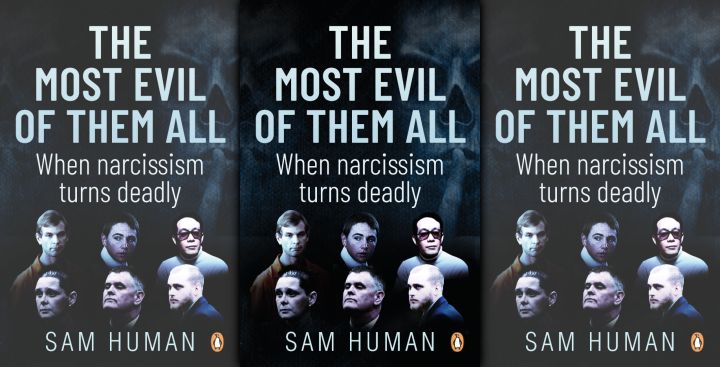BOOK EXCERPT
‘The Most Evil of Them All’ examines the psychopathic narcissism of a serial killer

This excerpt analyses the life and motivations of Kobus Geldenhuys, aka the Norwood Serial Killer, South Africa’s ‘closest equivalent’ to Ted Bundy.
In The Most Evil of Them All, Sam Human explores the role of narcissistic personality disorder in serial murder, surveying infamous and lesser known serial offenders from South Africa and around the world.
From Jeffrey Dahmer to Harold Shipman to the Griekwastad murderer Don Steenkamp, the book reveals the role pathological narcissism might have played in some of the most notorious and gruesome criminal cases of our times.
In this excerpt, Human examines the life of Kobus Geldenhuys – the “Norwood Serial Killer” – who she describes as South Africa’s “closest equivalent to psychopathic narcissist Ted Bundy”.
Geldenhuys, who was a police officer, carried out his crimes in the suburb of Norwood in Johannesburg between 1991 and 1992.
The only child of an “austere and fanatically religious mother and a ‘hands-off’, disinterested father who existed merely in the shadow of his overbearing wife”, Geldenhuys began stealing money from his mother at the age of 10, and by 13 he was housebreaking.
According to Human, Geldenhuys’s more serious crimes “bear some eerie resemblances” to those of Bundy. Both broke into women’s homes to commit brutal rapes and murder, both planned their attacks carefully and patiently, both had a superior disregard for authority, and both showed no empathy or remorse.
In 1993, Geldenhuys was sentenced to five death sentences and three life sentences, plus 23 years, for multiple rapes and robberies. His death sentences have since been commuted to jail time. This is an excerpt from the book.
***
Aware that his fellow detectives were on his trail, Geldenhuys asked for a transfer to the Internal Stability Unit in Alexandra, Johannesburg. His request was granted. In early 1992, Geldenhuys, now living with his parents, struck a fifth time. He raped and murdered the neighbour’s sixteen-year-old daughter: ‘He dragged the 16-year-old into her mother’s bedroom, ripped off her blouse and demanded she take off her jeans. Geldenhuys then forced Veronica Tayler to lie on the edge of the bed before sexually assaulting her. Then he fired a bullet into her forehead at point-blank range.’ (Lazarus: Bait: To Catch a Killer)
Ballistics testing on a bullet cartridge left at the crime scene matched a police-issued firearm. This, together with other ballistics evidence from previous crime scenes, spelled the end of Geldenhuys’s wretched pastime. He had also left plenty of additional evidence, in the form of DNA in his semen and saliva, at each of the crime scenes, making the work of investigators relatively easy.
Interestingly, there was a strange anomaly in Geldenhuys’s genetic code, which eventually led to his conviction. Like Ukrainian serial murderer Andrei Chikatilo, who murdered fifty-two women and children between 1978 and 1990 (we will discuss him a bit later), Geldenhuys had a rare genetic mutation: his blood type differed from the genetic coding of his other bodily fluids. His blood type was A+ while his semen was O+.
Geldenhuys reportedly didn’t resist arrest. He couldn’t seem to care less. According to Lazarus: ‘Shrugging nonchalantly, he nodded his head when he was asked if he was guilty of the crimes. He told investigators that his first murder had drained him emotionally.’
During Geldenhuys’s confession, he admitted to a further two murders, both of which had taken place in 1989. His first victim was Fransiwa Tundzi, his parents’ neighbours’ domestic worker. On the morning of May 1989, allegedly out of boredom, Geldenhuys climbed onto his neighbours’ garage roof to access their backyard. Once there, he shoved a terrified Fransiwa into her room and proceeded to bludgeon and strangle her to death. It was never established whether Geldenhuys also raped her, because he had thrown burning papers onto her corpse to destroy any evidence.
This savage crime took place while Geldenhuys was planning his nuptials to his then fiancée. Fortunately for the unsuspecting bride-to-be, her father was not impressed with Geldenhuys’s lack of ambition and put a stop to the wedding. Their relationship ended soon after.
It was just four months after their break-up that Geldenhuys murdered his second victim, in an apartment deliberately chosen for its proximity to where his former fiancée lived. Geldenhuys broke into the flatlet of Susanna Wandrag, a seventy-four-year-old pensioner who lived alone, struck her over the head and shot her in the mouth.
Geldenhuys was sentenced to five death sentences (the death penalty was still in effect in South Africa) plus three life sentences and twenty-three years for multiple rapes and robberies. His death sentences have since been commuted to jail time.
Journalist Janine Lazarus came to write her book about the Norwood Serial Killer because she had played an integral part in his capture. She had worked tirelessly with the police and put her own life in jeopardy as a crime reporter, going undercover to help catch Geldenhuys.
Immediately after his trial, Lazarus was granted an exclusive interview with him. The first thing that struck her was how incredibly normal Geldenhuys seemed – just an ordinary guy you would pass indifferently on the street:
His brown, long-lashed, doe-like eyes, inexplicably and incongruously soft, seemed an utterly inconceivable fit for a monster who had silenced the terrified women he pistol-whipped and raped with a bullet to the head.
Geldenhuys showed resignation rather than remorse, saying that he could not explain why he was compelled to do what he did. He just couldn’t help himself. Was he a psychopath? Definitely. The experts agree on that. Each crime was organised and well planned – bar one, the murder of Fransiwa Tundzi, which may have been more opportunistic. The surveillance of his victims and the exploitation of his occupation as a policeman to abet his crimes, as well as the remorseless rape and murder of the women, speak to a cold-blooded, psychopathic killer.
Psychologist and former serial profiler for the SAPS Dr Gérard Labuschagne, who has been granted numerous interviews with Geldenhuys over the years, claims:
Kobus is a psychopath with a lack of any kind of empathy. He doesn’t experience anything. The world doesn’t create a reaction in him. There is no happiness, sadness, anxiety, or fascination. He doesn’t have any drive or any passion about anything really.
Beyond this psychopathic profile, there are a few signs of NPD at play here. Geldenhuys brazenly harmed the very women whom, as a police officer, he was sworn to protect, and he did so right under his colleagues’ noses, even revisiting the crime scenes under the guise of a concerned policeman. It must have been amusing, perhaps satisfying, to relive the brutal attacks surrounded by his colleagues.
Furthermore, instead of fleeing the scene after each attack, Geldenhuys reportedly took items from his victims’ refrigerators to ‘quench his thirst with milk or orange juice’. As recounted, he also bade one of his older victims ‘good night’ after raping her, and even joked with another about AIDS: ‘He asked his first elderly victim if she had Aids before he raped her. He thought that was funny.’ (Lazarus: Bait: To Catch a Killer)
Geldenhuys’s crimes appear to reflect aspects of the ‘introverted, vulnerable narcissist’ (discussed in the Introduction) who reacts poorly to rejection and criticism, often by way of undesirable defensive behaviours. When the ‘quieter, more reserved narcissist’ doesn’t get the attention they crave, these reticent types, who typically harbour a deeper subconscious sense of worthlessness than their extraverted counterparts, may react with uncontrollable aggression, if not deadly rage.
Deep-seated insecurities and low self-esteem have the potential to morph into a pathological form of narcissistic personality disorder, typically characterised by uncontainable anger and a lack of empathy. From a physiological perspective, Geldenhuys appeared to also struggle with sexual dysfunction: ‘he prematurely ejaculated in one crime and had problems having sex with his last victim and also prematurely ejaculated’. (Labuschagne: Profiler podcast, Episode 10: ‘The Norwood Serial Killer’)
Considering this and acknowledging his upbringing under the harsh fist of a contemptuous, fanatical mother and an emotionally ‘absent’ father, it is unlikely that Geldenhuys experienced real affection or tenderness during his childhood and likely developed a heightened sense of worthlessness.
This left him ill-equipped to nurture loving connections with members of the opposite sex or gain the confidence to enjoy healthy sexual encounters, which may have exacerbated a damaged self-esteem and feeling of desolation.
In his Profiler podcast, Labuschagne explains that Geldenhuys ‘felt more alive when he was raping and killing than in a normal day. He had limited emotions, and even fewer facial expressions, compared to the average person. Geldenhuys felt no remorse whatsoever for his actions – he was definitely psychopathic.’
As noted, his murders were premeditated, and he always had associations with the crime scenes. He didn’t appear to derive any sexual pleasure from his crimes; for him, it was more about power, control and sexual experimentation: ‘he wanted to have sex with one victim without a condom to see what it was like’, recounts Labuschagne. With his last two murders, he appeared to be developing a taste for staging the victims’ bodies, rearranging them post-mortem. He placed his last victim’s house keys above her pubic area.
According to Labuschagne, Geldenhuys was not interested in boasting and did not care what others thought of him. He was only concerned with his own feelings and the positive reinforcement his crimes provided. He viewed his victims as objects in the pursuit of pleasure: ‘The break-ins, the rapes, the murders all gave him an “emotional spike” to feel something.’
In addition to Geldenhuys’s psychopathic profile, there may be evidence of underlying pathological narcissism. During a 2011 parole hearing, Geldenhuys claimed that if he was released, ‘he would like to work in the hospitality industry on cruise-ships’.
Lazarus spoke with Geldenhuys for a second time, in October 2020, twenty-eight years after his incarceration. ‘I always felt dead inside,’ he told her. ‘The robberies, rapes, and murders made me come alive. I felt bigger when I did these things. I became something.’ He appeared emotionless, empty inside, with no apparent conscience – Lazarus describes him as a ‘cardboard cut-out’. DM
The Most Evil of Them All by Sam Human is published by Penguin Random House (R300). Visit The Reading List for South African book news, daily – including excerpts!




















 Become an Insider
Become an Insider
Comments - Please login in order to comment.